|
|

|
Porsche, and the Porsche crest are registered trademarks of Dr. Ing. h.c. F. Porsche AG.
This site is not affiliated with Porsche in any way. Its only purpose is to provide an online forum for car enthusiasts. All other trademarks are property of their respective owners. |
|
|
| GregAmy |
 Nov 6 2021, 09:17 AM Nov 6 2021, 09:17 AM
Post
#1
|
|
Advanced Member     Group: Members Posts: 2,510 Joined: 22-February 13 From: Middletown CT Member No.: 15,565 Region Association: North East States 
|
Have we decided on which is our official Mega/MicroSquirt thread yet? If so then merge this into it.
I recently took the Microsquirt 914 on a 5-hour each way journey from Connecticut to New Jersey Motorsports Park. I was a bit hesitant to substitute my comfy radio-A/C-and-DSG-equipped GTI for a 45-yr-old ride through the wilds (and traffic) of NYC, but the weather was forecast to be a nice Fall day so I went for it. Loved it. Car ran flawlessly and the engine was a smooooooooooth as I've ever experienced it. No stumbles, no faults, ran cool on CHT and oil, just an absolute pleasure. 27.5 mpg average on 89 pump gas. But of course, with no radio (by choice) I had a lot of time to think about my tuning as I was tootling down the parkways and interstates, watching the Android tablet display of engine parameters...it runs good, and it sounds good, and it feels good, but...is it actually good? One of the biggest issues I faced/am facing with tuning is not the mechanics of the process; I quickly figured out how to use TunerStudio and Megalog, and I'm logging to either laptop or an Android tablet (ShadowTuner) via Bluetooth. And the VE Analyze function of Megalog makes it quite easy to review the AFR outputs in the logs and make changes to meet my AFR goals. No, that's the easy part. The hard part is knowing where our engines want to be, for example in terms of AFR and ignition timing. "Take it to the dyno!" you'll say. And you'd absolutely be right. But there's two problems with that. First, dyno time ain't cheap if you want to do it right. It's not just a matter of showing up and tuning the VE tables to meet the AFR goals (and I can do that on the street). No, to do it right you need to spend an afternoon, or even a day, with a skilled tuner who can run the engine through a series of tests and tickle the edges safely to discover things. The second factor relates directly to the first: finding a skilled tuner that not only understands the concepts of dyno tuning but also understands the needs and desires of a 75-year-old air-cooled engine design. Sure, the basics are the same as other engines, but I suggest the edges are much much fuzzier. If I had someone with that talent in my area I'd absolutely leverage them. But I don't. I have some local guys that are good with their dynos but they're Honda guys, or Chevy guys; When I bring my 914 to them (and I have) they're glad to take my couple hours' money but other than tuning to my settings they're not really qualified to tickle (and if they're smart, they're not comfortable trying to tickle the unknown edges on a customer's car). So any dyno work I've done was to my AFR and ignition settings. And I really don't know what I'm doing either. I don't know what air-cooled dyno tuning experience there may be on this board, but I'd love to begin sharing some info on where we're going with these Micro/Mega installations. Where do these engines want to be? How much can (or should) we push them? What symptom(s) are we looking for to decide if we need more or less of anything? What's the sweet - and safe - spots? I'm atttaching my AFR target and ignition tables, let me know what you think. Am I in the ballpark? I'm not asking you for any secrets. I'm just looking for some feedback to understand if I'm setting myself up for problems in the future. This is not my race car, I'm not looking for that nth hp advance; this is my street car, one that gets driven only 3000 miles a year (if I'm lucky, especially lately). I want to enjoy it and not worry about it. And maybe I'll learn something in the process. And...discuss! - GA Attached image(s) 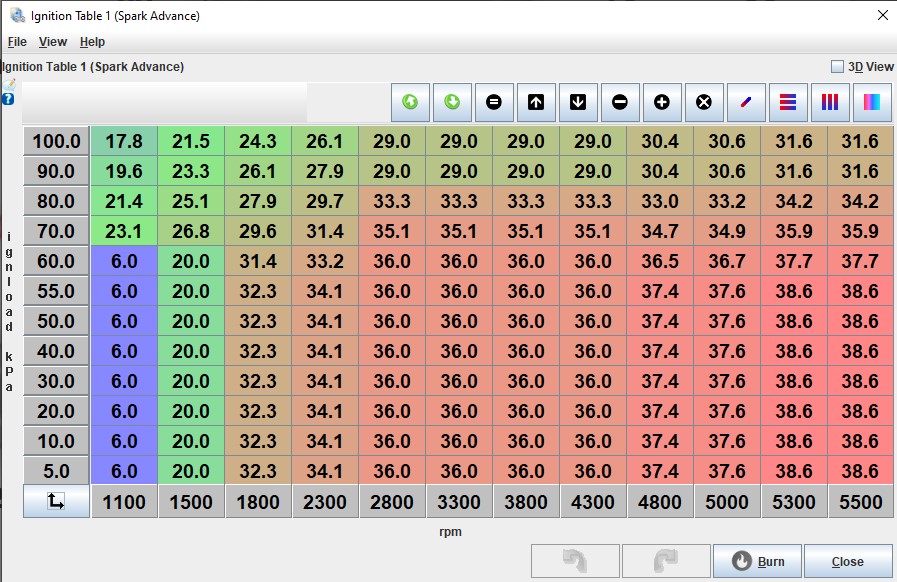 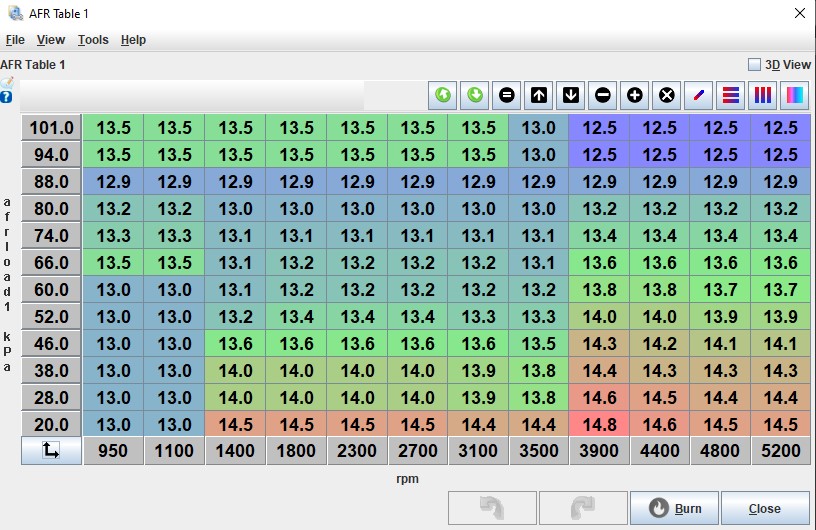
|
  |
Replies
| falcor75 |
 Nov 8 2021, 11:01 AM Nov 8 2021, 11:01 AM
Post
#2
|
|
Senior Member    Group: Members Posts: 1,579 Joined: 22-November 12 From: Sweden Member No.: 15,176 Region Association: Scandinavia 
|
I dont run MS on my car but I figured I could post my tables and maybe there is something someone can learn from them. My engine is a 2256 cc, 10.3:1 compression running 40 mm ITB's so the table setup is reflecting that with Alpha-N and its running in wasted spark.
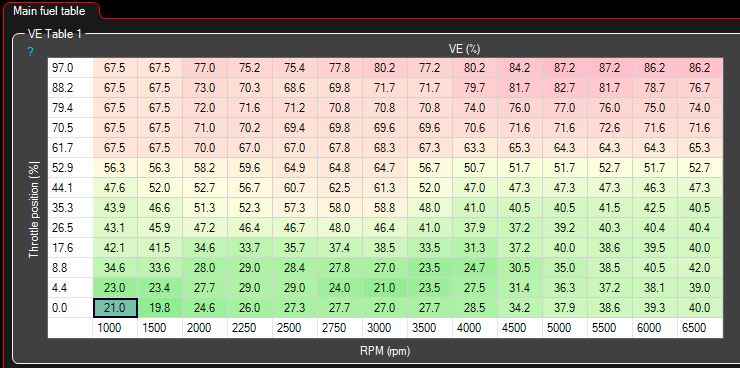 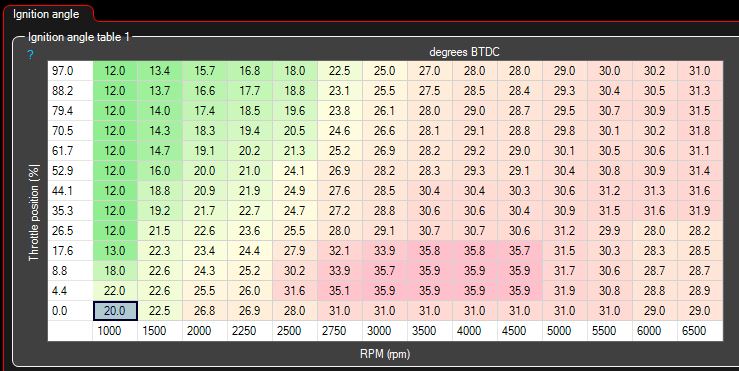 The darker pink area in the ignition table is basically my cruise settings. Its usually done between 12-15% throttle opening. Cruise CHT temps is in the 280-330 range with cyl 1 being the hottest one and always 25-30 F higher than the others. 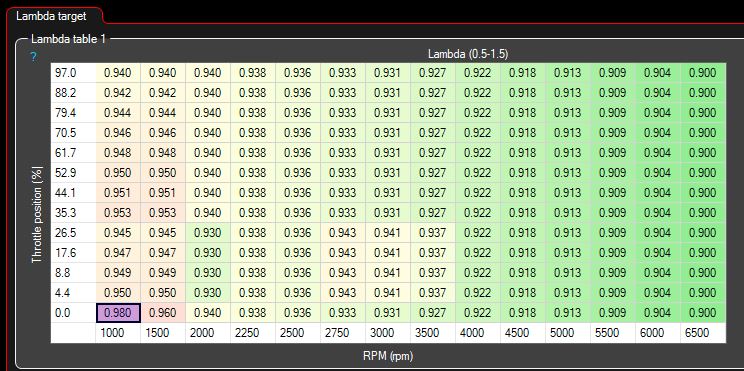 I have a friend thats tuned it for me and the priorities was. 1. Safety (never lean, no detonation etc) 2. Driveability (wide torque range) 3. Power (connected to the above) 4. Milage 5. Emissions (only measured every two years and at idle) |
| JamesM |
 Nov 8 2021, 01:23 PM Nov 8 2021, 01:23 PM
Post
#3
|
|
Advanced Member     Group: Members Posts: 2,103 Joined: 6-April 06 From: Kearns, UT Member No.: 5,834 Region Association: Intermountain Region |
I dont run MS on my car but I figured I could post my tables and maybe there is something someone can learn from them. My engine is a 2256 cc, 10.3:1 compression running 40 mm ITB's so the table setup is reflecting that with Alpha-N and its running in wasted spark.  I dont know about learning anything, but I can tell from your fuel map that your cam sure isnt stock!!! And I thought my motor was a screamer, that thing must be tons of fun once you hit 4k RPMs Are the 40mm TBs large enough to feed that thing? I tuned a 2270 with a milder cam and some smaller (i think 42mm) Jenvy ITBs and I could see a noticeable intake restriction in the datalogs. could have been his tiny air filters though. |
| GregAmy |
 Nov 8 2021, 01:54 PM Nov 8 2021, 01:54 PM
Post
#4
|
|
Advanced Member     Group: Members Posts: 2,510 Joined: 22-February 13 From: Middletown CT Member No.: 15,565 Region Association: North East States 
|
I dont know about learning anything, but I can tell from your fuel map that your cam sure isnt stock!!! Which reminds of two generic things I was thinking about. Is the VE table an actual indication of fuel flow, other than internally relative, given possible (probable) differences in installed injectors/fuel pressure? Said differently, is the VE map calculated in such a way to be generic that it can be used across a similar engines, regardless of fuel pressure and/or injectors? And, is the 3D VE map a good visual indicator of the torque curve? GA |
| JamesM |
 Nov 8 2021, 03:27 PM Nov 8 2021, 03:27 PM
Post
#5
|
|
Advanced Member     Group: Members Posts: 2,103 Joined: 6-April 06 From: Kearns, UT Member No.: 5,834 Region Association: Intermountain Region |
I dont know about learning anything, but I can tell from your fuel map that your cam sure isnt stock!!! Which reminds of two generic things I was thinking about. Is the VE table an actual indication of fuel flow, other than internally relative, given possible (probable) differences in installed injectors/fuel pressure? Said differently, is the VE map calculated in such a way to be generic that it can be used across a similar engines, regardless of fuel pressure and/or injectors? And, is the 3D VE map a good visual indicator of the torque curve? GA IF (and this is a big if because a lot of people miss this and dont) you have the REQ_FUEL constant configured correctly for your hardware (injector flow rate, engine displacement, and fuel type) than the VE (Volumetric efficacy) table should represent exactly that, the pumping efficiency of the engine at the specific load bins. You will notice that the REQ_FUEL value is actually represented in milliseconds and this is basically the injector pulse required to get a stoch burn with the specified fuel if the specified displacement was able to fill 100% with fresh air. I have seen a lot of people that treat REQ_FUEL as some sort of tuning parameter. It isnt, its a defined constant that should match your hardware. If you have your REQ_FUEL and dead time set correctly you should be able to swap injectors/fuel pressures etc without re-tuning anything provided you know the old and new flow rates, simply by updating the REQ_FUEL and dead time constants to match your new hardware. This is also one of the reasons that people sharing fuel maps and/or entire tunes tend to usually not work out so well. If your REQ_FUEL and injector dead time settings are not spot on any tune you build on top of them is only going to make sense with your specific build. I would say the VE map probably more closely mirrors Horsepower than torque. It for sure indicates where the engine is working most efficiently at ingesting air. Megalogviewer actually has some functionality to calculate horsepower based on log data however the accuracy of this (like everything else) requires that all the input constants for the calculation are set correctly in order to be remotely accurate. Most type 4s I have worked with tend to see peak VE #s in high 70s to mid 80s on finished tunes. Some performance builds wind up being higher than that. You will find that the peak VE values on a map then should line up pretty close with the peak power output for the motor. So just by looking at @falcor75 VE table, assuming the MAP is dialed in/accurate, one could assume his peak HP is probably happening somewhere around 5500 RPM, maybe a little higher. Stock 2.0Ls you will usually see the peak VE numbers closer to ~4700-4800 RPM. |
| GregAmy |
 Nov 8 2021, 04:37 PM Nov 8 2021, 04:37 PM
Post
#6
|
|
Advanced Member     Group: Members Posts: 2,510 Joined: 22-February 13 From: Middletown CT Member No.: 15,565 Region Association: North East States 
|
IF (and this is a big if because a lot of people miss this and dont) you have the REQ_FUEL constant configured correctly for your hardware (injector flow rate, engine displacement, and fuel type) than the VE (Volumetric efficacy) table should represent exactly that, the pumping efficiency of the engine at the specific load bins. ... I would say the VE map probably more closely mirrors Horsepower than torque. Good to know, and that makes sense. Mine seem to follow that, with the bigger numbers coming around where I'd expect to see peak HP. Non-demoninational, non-religious, generic 3D chart enclosed; peak VEs are at 4300 and 4800. QUOTE Most type 4s I have worked with tend to see peak VE #s in high 70s to mid 80s on finished tunes. Lol well I certainly done did it wrong, with many numbers exceeding 100 toward the top. But, as you describe, my "Required Fuel" was an initial WAG. It was based on TS' calculations from engine displacement and rated injector flow (Five-O 280cc injectors). I'm running a Bosch 3-bar pressure regulator. I don't see any value in changing it and re-doing the VE tables, unless that gives a knowledgeable tuner pause because he/she is working outside their comfort zone. I'd do it if I had to but I think I'd lose a lot of gain for where I am now. - GA Attached image(s) 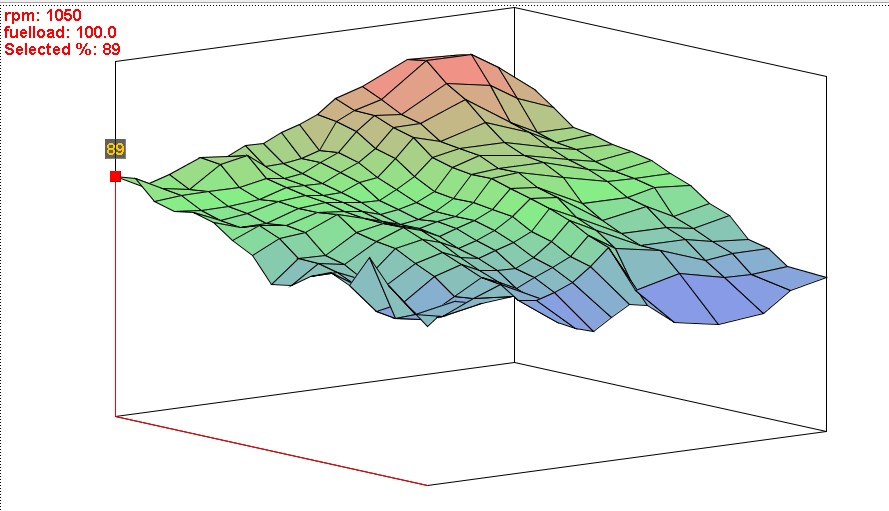
|
| JamesM |
 Nov 8 2021, 10:10 PM Nov 8 2021, 10:10 PM
Post
#7
|
|
Advanced Member     Group: Members Posts: 2,103 Joined: 6-April 06 From: Kearns, UT Member No.: 5,834 Region Association: Intermountain Region |
Lol well I certainly done did it wrong, with many numbers exceeding 100 toward the top. But, as you describe, my "Required Fuel" was an initial WAG. It was based on TS' calculations from engine displacement and rated injector flow (Five-O 280cc injectors). I'm running a Bosch 3-bar pressure regulator. I don't see any value in changing it and re-doing the VE tables, unless that gives a knowledgeable tuner pause because he/she is working outside their comfort zone. I'd do it if I had to but I think I'd lose a lot of gain for where I am now. - GA I dont think you got it wrong, if you are running the A280H injectors I am guessing you have REQ_FUEL set correctly as flow info and deadtimes actually come documented with them. Also, interestingly enough, when I switched from using stock 2.0 injectors to the A280H with a 3 bar regulator I saw my peak VE numbers jump above 100 as well. Why? Not 100% sure but i would assume the difference between the two injector sets is that everyone (myself included) has always guessed at the actual deadtime and voltage correction settings for the 2.0 injectors and so they were most likely wrong and throwing off my whole table, this was one of the major reasons I went to the new injectors. Knowing the exact injector specs I can now kick on my headlights at idle and not have my mixture shift on me. The other reason why seeing numbers above 100 on the VE table makes sense is that 100 represents perfect efficiency IF we had the bin tuned at 14.7 AFR, but in those bins we are fueling to mid/low 12s which mathematically then looks like we are more efficient when in fact we are just running rich of stoch. We could do the math then if you wanted to know the "actual" engine VE, basically (Target AFR/14.7)*Table VE=Real VE So if you are seeing 105 VE in your table running at 12.3 AFR the pumping efficiency of the engine is really ~87% which is in the realm of believability for a mild performance cam. This of course assumes you don't have anything else factoring into the fuel equation at the time (like having turned on incorporate AFR targets) CAM, Intake, and exhaust all impact VE as well. |
Posts in this topic
 GregAmy The Mega/Microsquirt Mega Thread Nov 6 2021, 09:17 AM
GregAmy The Mega/Microsquirt Mega Thread Nov 6 2021, 09:17 AM
 Montreal914 :popcorn: :popcorn: :popcorn: :D Nov 6 2021, 10:12 AM
Montreal914 :popcorn: :popcorn: :popcorn: :D Nov 6 2021, 10:12 AM
 BeatNavy Good stuff, Greg, thanks for posting. I've go... Nov 6 2021, 11:28 AM
BeatNavy Good stuff, Greg, thanks for posting. I've go... Nov 6 2021, 11:28 AM
 Montreal914 Nowhere near your level of expertise/experience bu... Nov 6 2021, 11:40 AM
Montreal914 Nowhere near your level of expertise/experience bu... Nov 6 2021, 11:40 AM

 GregAmy :beer2:
...You have a lot more advance than I do.... Nov 6 2021, 11:56 AM
GregAmy :beer2:
...You have a lot more advance than I do.... Nov 6 2021, 11:56 AM
 falcor75 A good idea is to include the specs of the engine ... Nov 6 2021, 01:59 PM
falcor75 A good idea is to include the specs of the engine ... Nov 6 2021, 01:59 PM

 BeatNavy
A good idea is to include the specs of the engine... Nov 6 2021, 02:14 PM
BeatNavy
A good idea is to include the specs of the engine... Nov 6 2021, 02:14 PM

 GregAmy
A good idea is to include the specs of the engine... Nov 6 2021, 03:29 PM
GregAmy
A good idea is to include the specs of the engine... Nov 6 2021, 03:29 PM
 bkrantz Thanks for setting up this thread. I am several w... Nov 6 2021, 08:05 PM
bkrantz Thanks for setting up this thread. I am several w... Nov 6 2021, 08:05 PM
 bbrock Thanks for starting this thread! It's alm... Nov 6 2021, 08:05 PM
bbrock Thanks for starting this thread! It's alm... Nov 6 2021, 08:05 PM

 BeatNavy
To that end, I thought I'd start with an igni... Nov 7 2021, 06:23 AM
BeatNavy
To that end, I thought I'd start with an igni... Nov 7 2021, 06:23 AM

 JamesM
I must admit I'm not 100% sure of the relatio... Nov 7 2021, 11:19 PM
JamesM
I must admit I'm not 100% sure of the relatio... Nov 7 2021, 11:19 PM

 BeatNavy
So if you are talking about the setting I think y... Nov 8 2021, 06:43 AM
BeatNavy
So if you are talking about the setting I think y... Nov 8 2021, 06:43 AM

 JamesM
That equation makes perfect sense. I had to look... Nov 9 2021, 12:53 AM
JamesM
That equation makes perfect sense. I had to look... Nov 9 2021, 12:53 AM
 GregAmy I don't understand those paragraphs from Tunde... Nov 7 2021, 06:39 AM
GregAmy I don't understand those paragraphs from Tunde... Nov 7 2021, 06:39 AM

 BeatNavy
I don't understand those paragraphs from Tund... Nov 7 2021, 07:15 AM
BeatNavy
I don't understand those paragraphs from Tund... Nov 7 2021, 07:15 AM
 GregAmy Try the overrun cut; here's mine. Should be da... Nov 7 2021, 07:43 AM
GregAmy Try the overrun cut; here's mine. Should be da... Nov 7 2021, 07:43 AM
 bbrock Thanks for posting that AFR table with circles Rob... Nov 7 2021, 10:25 AM
bbrock Thanks for posting that AFR table with circles Rob... Nov 7 2021, 10:25 AM
 bbrock And Greg, can Shadow Tuner log mpg? I read about ... Nov 7 2021, 10:28 AM
bbrock And Greg, can Shadow Tuner log mpg? I read about ... Nov 7 2021, 10:28 AM

 BeatNavy
And Greg, can Shadow Tuner log mpg? I read about... Nov 7 2021, 10:58 AM
BeatNavy
And Greg, can Shadow Tuner log mpg? I read about... Nov 7 2021, 10:58 AM
 JamesM SOOOO much to comment on here, both general inform... Nov 7 2021, 12:19 PM
JamesM SOOOO much to comment on here, both general inform... Nov 7 2021, 12:19 PM

 BeatNavy
SOOOO much to comment on here, both general infor... Nov 7 2021, 01:43 PM
BeatNavy
SOOOO much to comment on here, both general infor... Nov 7 2021, 01:43 PM

 JamesM
SOOOO much to comment on here, both general info... Nov 7 2021, 10:38 PM
JamesM
SOOOO much to comment on here, both general info... Nov 7 2021, 10:38 PM
 JamesM
Loved it. Car ran flawlessly and the engine was a... Nov 8 2021, 12:26 AM
JamesM
Loved it. Car ran flawlessly and the engine was a... Nov 8 2021, 12:26 AM

 GregAmy In some cases it may be a bit subjective, I guess ... Nov 8 2021, 07:40 AM
GregAmy In some cases it may be a bit subjective, I guess ... Nov 8 2021, 07:40 AM

 falcor75
I dont run MS on my car but I figured I could po... Nov 8 2021, 01:50 PM
falcor75
I dont run MS on my car but I figured I could po... Nov 8 2021, 01:50 PM

 falcor75
I dont know about learning anything, but I can te... Nov 8 2021, 02:03 PM
falcor75
I dont know about learning anything, but I can te... Nov 8 2021, 02:03 PM

 JamesM Still working on this one, few things left to dial... Nov 8 2021, 10:28 PM
JamesM Still working on this one, few things left to dial... Nov 8 2021, 10:28 PM

 JamesM This probably also worth noting as i know we have ... Nov 8 2021, 10:39 PM
JamesM This probably also worth noting as i know we have ... Nov 8 2021, 10:39 PM

 JamesM Anyone want more math exercises or for me to expla... Nov 8 2021, 10:54 PM
JamesM Anyone want more math exercises or for me to expla... Nov 8 2021, 10:54 PM
 bbrock I'm learning :Qarl:
In my noodling around tr... Nov 8 2021, 09:11 PM
bbrock I'm learning :Qarl:
In my noodling around tr... Nov 8 2021, 09:11 PM  |
1 User(s) are reading this topic (1 Guests and 0 Anonymous Users)
0 Members:

|
Lo-Fi Version | Time is now: 15th July 2025 - 09:03 AM |
Invision Power Board
v9.1.4 © 2025 IPS, Inc.








